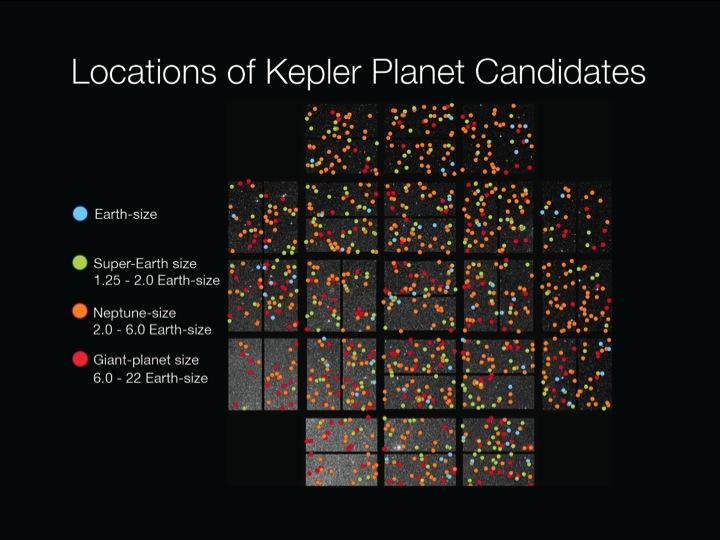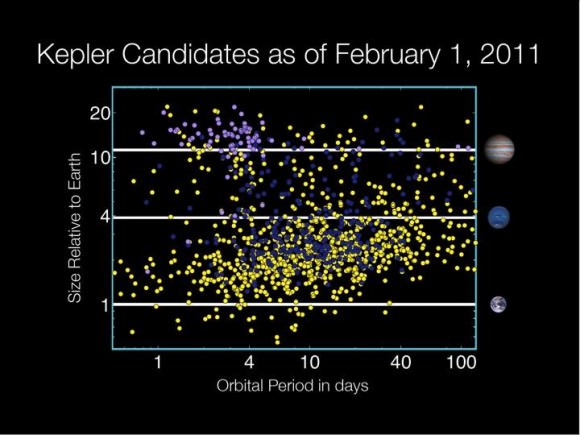NASA To Announce New Planetary Discoveries
WASHINGTON -- NASA will host a news briefing at 1 p.m. EST, Wednesday, Feb. 2, to announce the Kepler mission's latest findings about planets outside our solar system. The briefing will be held in the NASA Headquarters auditorium at 300 E St S.W. in Washington and carried live on NASA Television and the agency's website at http://www.nasa.gov/ntv.
Kepler is the first NASA mission capable of finding Earth-size planets in or near the "habitable zone," the region in a planetary system where liquid water can exist on the surface of the orbiting planet. Although additional observations will be needed over time to achieve that milestone, Kepler is detecting planets and planet candidates with a wide range of sizes and orbital distances to help us better understand our place in the galaxy.
The news conference will follow the scheduled release of Kepler mission science data on Feb. 1.
The data release will update the number of planet candidates and is based on observations conducted between May 2 and Sept. 17, 2009. Participants are:
-- Douglas Hudgins, Kepler program scientist, NASA Headquarters, Washington
-- William Borucki, Kepler Science principal investigator, NASA's Ames Research Center, Moffett Field, Calif.
-- Jack Lissauer, Kepler co-investigator and planetary scientist, Ames
-- Debra Fischer, professor of Astronomy, Yale University, New Haven, Conn.
Reporters also may ask questions from participating NASA field centers or by phone. To obtain dial-in information, journalists must send their name, affiliation and telephone number to Steve Cole by e-mail at stephen.e.cole@nasa.gov by noon EST on Feb. 1.
For more information about the Kepler mission and to view the Feb. 1 data release, visit:
http://www.nasa.gov/kepler
Link: nasa.gov
Allora, qui abbiamo tre astrobiologi ed un'astrofisica.
Che sia la volta buona, per la scoperta di un pianeta di taglia simile alla Terra, nella fascia abitabile della sua stella, al di fuori del nostro sistema solare...
Con evidenze di un'atmosfera e magari, con tracce di composti organici ?
Aspettiamo il tardo pomeriggio del 2 febbraio e lo sapremo.
Comunque, vista l'ubicazione di questo annuncio, l'auditorio nel quartier generale della Nasa, che se non ricordo male, è lo stesso dei batteri all'arsenico, non dovrebbe essere una scoperta di poco conto.
Diciamo...di un certo impatto.
Se poi, lo sarà soprattutto per la "stretta" comunità scientifica...
Andrà bene e sopravviveremo, ugualmente.
NASA to Announce New Discoveries About Alien Planets
LA NASA ANNUNCIA UNA NUOVA SCOPERTA A RIGUARDO DI PIANETI ALIENI
( in inglese - space.com ).
Planet Data to Fuel Hunt for Life
I DATI DI UN PIANETA ALIMENTANO LA CACCIA PER LA VITA
New Information from NASA Could Offer Evidence of a Habitable World Beyond Our Solar System
NUOVE INFORMAZIONI DALLA NASA OFFRIREBBERO EVIDENZA DI UN MONDO ABITABILE AL DI LÀ DEL NOSTRO SISTEMA SOLARE
( in inglese - online.wsj.com ).
Hunting for Earth-like Alien Planets: Q & A with Astronomer Geoff Marcy
CACCIANDO PIANETI ALIENI SIMILI ALLA TERRA: DOMANDE E RISPOSTE CON L'ASTRONOMO GEOFF MARCY
( in inglese - space.com ).
Aggiornamento...
NASA Telescope Reveals Over 1,000 New Potential Alien Planets
UN TELESCOPIO DELLA NASA RIVELA OLTRE 1.000 NUOVI POTENZIALI PIANETI ALIENI
( in inglese - space.com ).
Da un articolo da altra fonte, risulterebbe dai dati rilasciati oggi, che circa una sessantina sarebbero alla giusta distanza dalla loro stella per avere il potenziale per ospitare la vita, come noi la conosciamo.
Che vi posto a seguire...
New-Found Cornucopia of Exoplanets More Than Doubles the Current Cosmic Census
UNA NUOVA ABBONDANTE SCOPERTA DI ESOPIANETI PIÙ CHE RADDOPPIA IL CORRENTE CENSIMENTO COSMICO
( in inglese - popsci.com ).
Ora, non ci resta che aspettare conferme definitive, ed eventualmente altre informazioni in merito.
Ecco la conferma...
Kepler Planet Hunter Finds 1,200 Possibilities
By DENNIS OVERBYE
Published: February 03, 2011
Astronomers have cracked the Milky Way like a piñata, and planets are now pouring out so fast that they don't know what to do with them all.
In a long-awaited announcement, scientists operating NASA's Kepler planet-hunting satellite reported Wednesday that they had identified 1,235 possible planets orbiting other stars, potentially tripling the number of known planets in the universe.
Of the new candidates, 68 are one-and-a-quarter times the size of the Earth or smaller - smaller, that is, than any previously discovered planets outside the solar system. Fifty-four of the possible exoplanets are in the so-called habitable zones, where temperatures should be moderate enough for liquid water, of stars dimmer and cooler than the Sun; four of these are less than twice the size of Earth, and one is even smaller.
Continua, sempre in inglese, su: nytimes.com
Ed ancora, sempre dall'articolo...
In a separate announcement, to be published in Nature on Thursday, a group of Kepler astronomers led by Jack Lissauer of Ames said they had found a star with six planets - the most Kepler has yet found around one star - orbiting in close ranks in the same plane, no farther from their star than Mercury is from the Sun.
Quindi, fra la massa di questi nuovi pianeti scoperti, vi è anche un sistema solare di una stella molto simile alla nostra, con sei pianeti che gli ruotano attorno.
Come riportato, anche nel seguente articolo, in italiano...
SPAZIO
Scoperto primo sistema solare con sei piccoli pianeti
Individuato dal telescopio spaziale Kepler della Nasa, dista 2000 anni luce dalla Terra.
Sembrerebbe possibile che due dei corpi celesti che ruotano intorno a una stella simile al Sole siano composti da acqua
Continua su: repubblica.it
Ed ancora...
NASA Identifies 54 Potentially Habitable Alien Planets
LA NASA IDENTIFICA 54 PIANETI ALIENI POTENZIALMENTE ABITABILI
( in inglese - space.com ).
Da cui...

E dal seguente articolo, che penso risulti di più facile comprensione...
Kepler Discovers First Earth Sized Planets inside Habitable Zone
KEPLERO SCOPRE I PRIMI PIANETI CON LA TAGLIA DELLA TERRA ALL'INTERNO DELLA ZONA ABITABILE
( in inglese - universetoday.com ).
Riporto seguenti grafici esplificativi...



Nessun commento:
Posta un commento